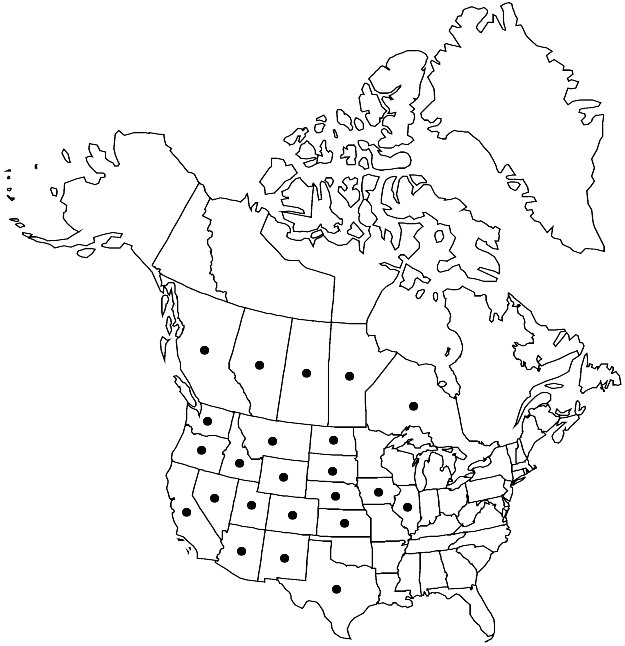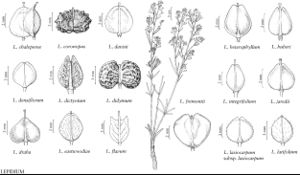Difference between revisions of "Lepidium chalepense"
Cent. Pl. II, 23. 1756.
FNA>Volume Importer |
FNA>Volume Importer |
(No difference)
| |
Revision as of 20:24, 24 September 2019
Perennials; (rhizomatous); densely hirsute to glabrate or glabrous. Stems several from base, erect or decumbent basally, branched (several) distally, (0.8–)2.1–6.6(–9.2) dm. Basal leaves (early withered); not rosulate; petiole 0.9–4.4 cm; blade obovate, spatulate, or ovate, (1.8–)2.5–8.6(–14) cm × 10–37 mm, margins subentire or dentate. Cauline leaves sessile; blade obovate to oblong or lanceolate to oblanceolate, (1.5–)2.6–9.3(–13.2) cm × (7–)12–31(–45) mm, base sagittate-amplexicaul or auriculate, margins dentate or entire, (surfaces pubescent or glabrous). Racemes (corymbose panicles), elongated in fruit; rachis glabrous or puberulent, trichomes cylindrical, straight or curved. Fruiting pedicels ascending to horizontal, straight, (terete), 5–16(–19) × 0.2–0.3 mm, glabrous or sparsely puberulent adaxially. Flowers: sepals oblong to ovate, 1.7–3 × 1–1.6 mm; petals white, obovate, 3–5 × 1.2–2.4 mm, claw 1.2–2 mm; stamens 6; filaments 2–3.3 mm, (glabrous); anthers 0.5–0.6 mm. Fruits (indehiscent), obovoid to subglobose or obcompressed globose, 3.5–5.8(–7) × (3.5–)4–6.2(–7) mm, apically not winged, apical notch absent; valves thin, smooth, often not veined, glabrous; style (0.8–)1.2–2(–2.3) mm. Seeds (dark reddish brown), ovate, 1.5–2.3 × 1–1.3 mm. 2n = 48, 80, 128.
Phenology: Flowering May–Jun.
Habitat: Mountain slopes, roadsides, fields, agricultural lands, stream banks, pastures, waste areas
Elevation: 300-4200 m
Distribution

Alta., B.C., Man., Ont., Sask., Ariz., Calif., Colo., Idaho, Ill., Iowa, Kans., Mont., Nebr., Nev., N.Mex., N.Dak., Oreg., S.Dak., Tex., Utah, Wash., Wyo., Asia, introduced also in South America (Argentina), Europe.
Discussion
From the synonymy above, it is evident that the disposition of Lepidium chalepense has varied: more than one species (e.g., R. C. Rollins 1940; G. A. Mulligan and C. Frankton 1962), one species (e.g., Rollins 1993), a variety of Lepidium (Cardaria) draba (N. H. Holmgren 2005b), or a synonym of the latter species (C. L. Hitchcock 1936). In our opinion, the differences in fruit morphology and chromosome number justify its recognition as a distinct species.
Selected References
None.
